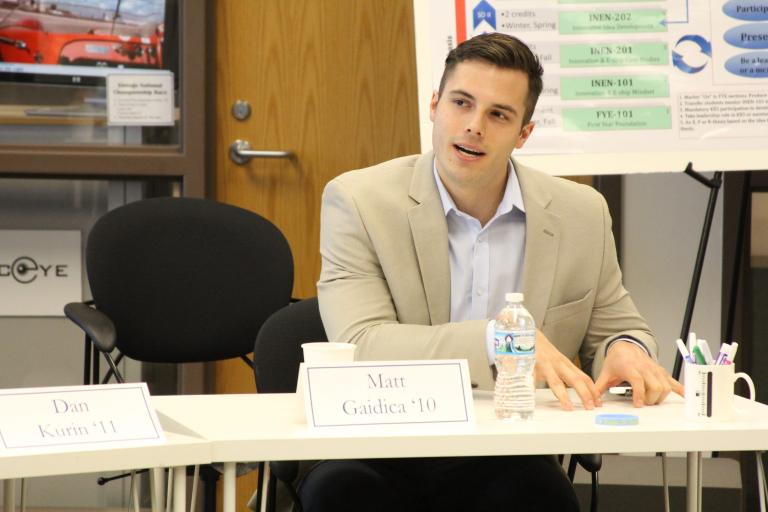
“Kettering does communications and teamwork really well but we need to develop influence for impact.”
President Robert K. McMahan moderated an entrepreneurship roundtable with Dr. James Zhang, provost and senior vice president for Academic Affairs, and eight prominent Kettering University alumni to discuss the current and future relationship between higher education and entrepreneurship on Dec. 3. The topic was spurred by the opening of the “T-Space” in the C.S. Mott Building.
“This [T-Space] represents the state in which things are done,” McMahan said. “The world in which we are graduating students requires innovation in these unique spaces.”
The T-Space is a place for light prototyping with access to 3D printing, laser and vinyl cutting, a variety of electronic gadgets, whiteboards, moveable furniture, music creation, communication devices and a green room for animation and multimedia production. In the near future, the space will contain servers that will provide students with access to software that may not otherwise be common on campus. The tools currently provided are plentiful for computer scientists and mechanical and electrical engineers to experiment. The purpose of the space is to assist students develop an innovation and entrepreneurial mindset while providing the tools to explore new technologies and inventions.
The alumni panel featured Dave Stenson '86, Dr. John Suh '90, Paul Glomski '99, Jesse Alleyne '07, Kristina Kamensky '09, Matt Gaidica '10, Dan Kurin '11 and Alex Barath '13.
(Clockwise from top left) Matt Gaidica '10, Dave Stenson '86, Paul Glomski '99 and Dr. John Suh '90.
“Students have a lot to teach companies,” Suh said. “This type of space doesn’t exist in companies."
The roundtable started by dissecting the relationship between a Kettering education and the corporate environments in which many students are placed. McMahan asked the participants in the roundtable what Kettering could do improve upon as an institution to better prepare students for innovation, entrepreneurship and greater fluidity in modern workplaces.
“Kettering does communications and teamwork really well but we need to develop influence for impact,” Alleyne said.
Alleyne believes that modern companies are looking for employees who can influence the workplace through intrapreneurship - students who can lead and invent as opposed to requiring management and oversight.
Alleyne, an enterprise account executive at Microsoft, also recalled his own experience working for a Pittsburgh-based startup to illustrate the point that companies are evolving from static long-term operations to agile and mobile solution-seekers.
“You will work 18 hours per day for two years and you will either be rich or we will be dead,” said Alleyne about the pitch that was made to him.
Then how should a Kettering student’s co-op experience change to account for this fast-paced innovation-based economy?
“Corporations are recognizing that they need to innovate internally,” Stenson said.
Stenson, who worked for General Motors for 29 years and is now the founder and chief executive officer of Inventev, also suggested companies should be encouraged to make Kettering students the brain trust or innovation center of their operations by letting them develop and provide solutions to modern problems.
Zhang suggested another possibility - allow students to bring co-op projects into innovative spaces like the T-Space in order to derive solutions for companies on Kettering’s campus. This utilizes the expertise of the faculty in addition to the students, provides companies with access to technical capabilities at Kettering all while keeping the focus on real-world problems and solutions.
This new potential model would also place a greater emphasis on research at Kettering which Gaidica noted can get lost between co-op and academic terms.
“Research labs are where innovation usually happens,” Gaidica said.
Gaidica founded numerous startups in Silicon Valley from 2010-2013 before enrolling in graduate studies in neuroscience at the University of Michigan earlier in 2014.
McMahan concluded the roundtable with a discussion about innovating and spurring entrepreneurship in Michigan and specifically in Flint.
“Entrepreneurial economies are ecosystems,” McMahan said. “What do we need to do in Flint to create this ecosystem?”
Stenson believes that Flint needs to return “back to its base” and back to “building things” - back to manufacturing.
“Flint and Detroit, they attract people who want to go against the grain,” said Glomski, founder and CEO of Detroit Labs. “The business communities in these cities support you when you’re in your most fragile state. That’s what attracted me to Detroit.”
McMahan feels that the greatest “leverage point” in Flint and in Michigan overall is the psyche to create and he hopes that will be reflected in the many future innovations and inventions that stem from the T-Space.
“The thing I love about Michigan - this is a culture of makers. People here make things and that’s in our psyche,” McMahan said. “We design and make things and that’s the advantage of Michigan. That’s what’s impressive about Michigan and its people.”